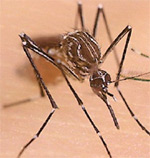Classification

Domain - Eukarya: Organisms in the Eukarya domain are classified as being single or multicellular organisms that contain a nucleus and membrane bound organelles.
Kingdom - Animalia: Eukaryotes within kingdom Animalia or Metazoa are categorized as being multicellular, heterotrophic, and lacking cell walls. Animals are located within the major clade Opisthokonta which is characterized by having motile cells with a single posterior flagella at some point during development.
Phylum - Arthropoda: Arthropods are described as being the most succesful group of animals within the animal kingdom. They are invertebrate species that possess an exoskeleton of chitin, segmented bodies, jointed appendages, and the ability to molt their outermost dermal covering to grow larger.
Class - Insecta: Insects are defined by having the key characteristics of three pairs of walking legs, jointed mouthparts, Johnston's organ in the antennae, and the ability to breathe through spiracles. Spiracles are small tubes of air that travel throughout the body that allow insects to directly exchange gases with the environment (Myer, 2001).

Figure 1. Phylogenetic tree showing the relationships insects have
with other organisms within the group Opisthokonta. Created by Megan
Beckman.
Order - Diptera: Diptera is distinct for having hind wings that are contained to simple club-shaped formations called halteres. Diptera are true flies and give birth to legless larvae. Species within this order can be herbivorous, parasitic, or saprophytic (able to feed on dead organic matter) (Meyer, 2009).
Family - Culicidae: Culicidae are more commonly
known as mosquitoes, and are defined as having a hump-backed
thorax, a proboscis that is sharp enough to penetrate the dermal
layer of other animal groups, and scale like formations on their
 wing veins (Meyer, 2010).
wing veins (Meyer, 2010).
Genus - Aedes: The ancient Greek word Aedes translates to "unpleasant" (Merriam-Webster, 2013). Female mosquitos in the Aedes genus are well known for transmitting pathogens including the dengue fever, yellow fever, and chikungunya fever viruses (Valent, 2013).
Species - Aedes aegypti: Otherwise known as the yellow fever mosquito, Aedes aegypti is characterized by having white lyre shaped markings on its thorax along with white bands that are present on the hind legs during the adult stage of its life.


Figure 2. Phylogenetic tree showing species closely related to A.
aegypti, and their relationship to other organisms in the order
Diptera. Created by Megan Beckman.
For more detailed information about the classfication of this species, other species, or organisms in general, please visit the Tree of Life web project.

